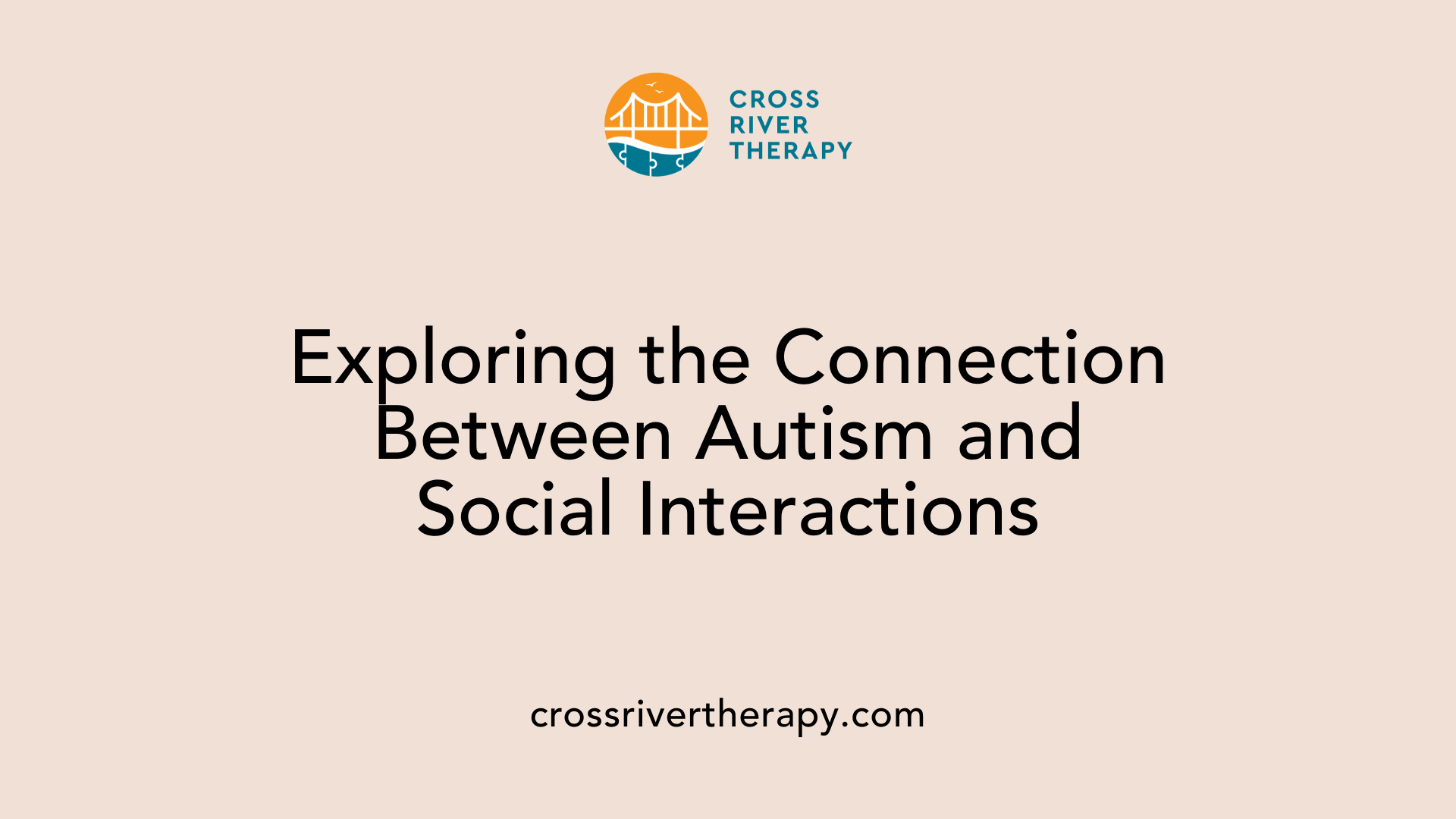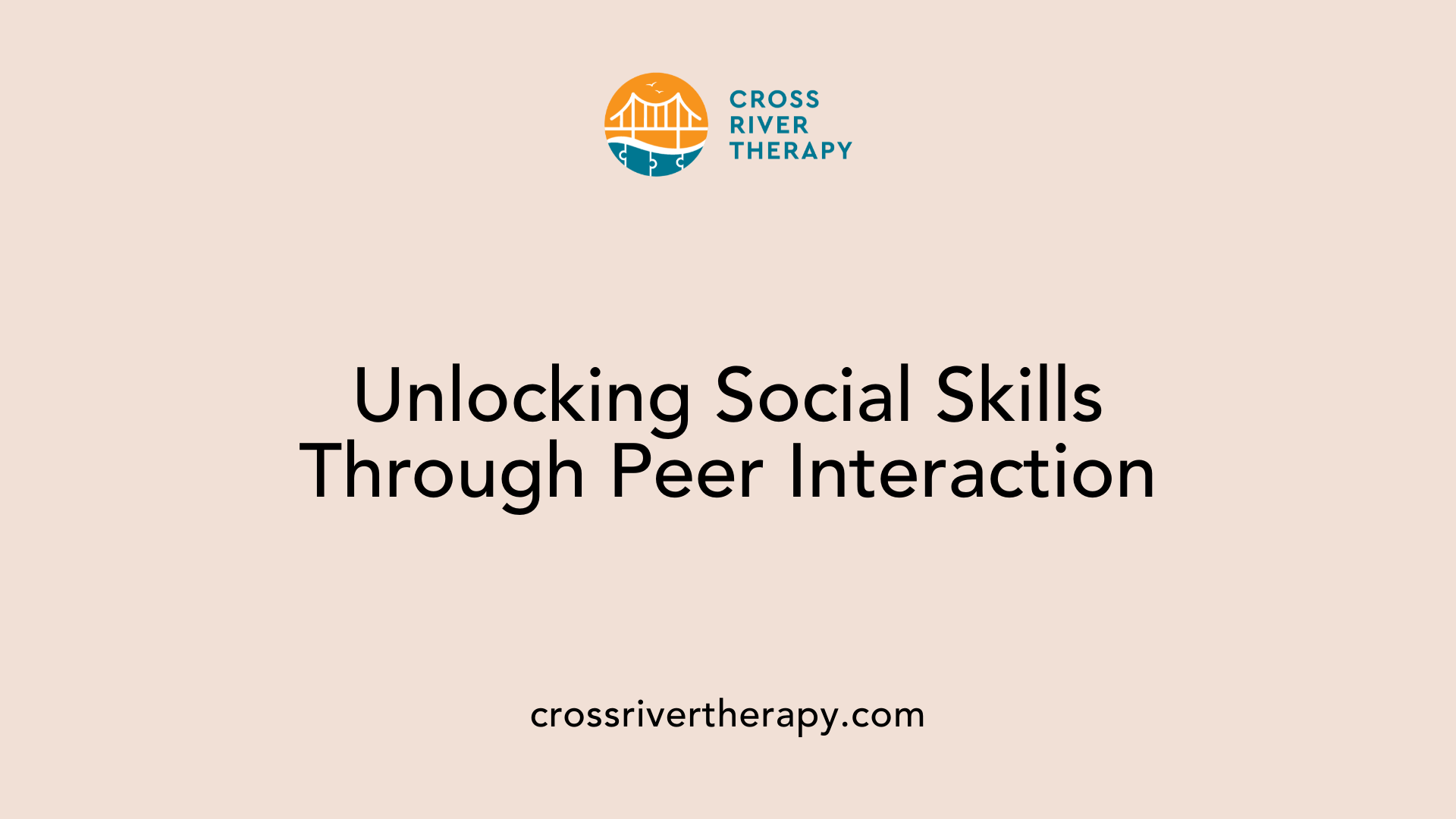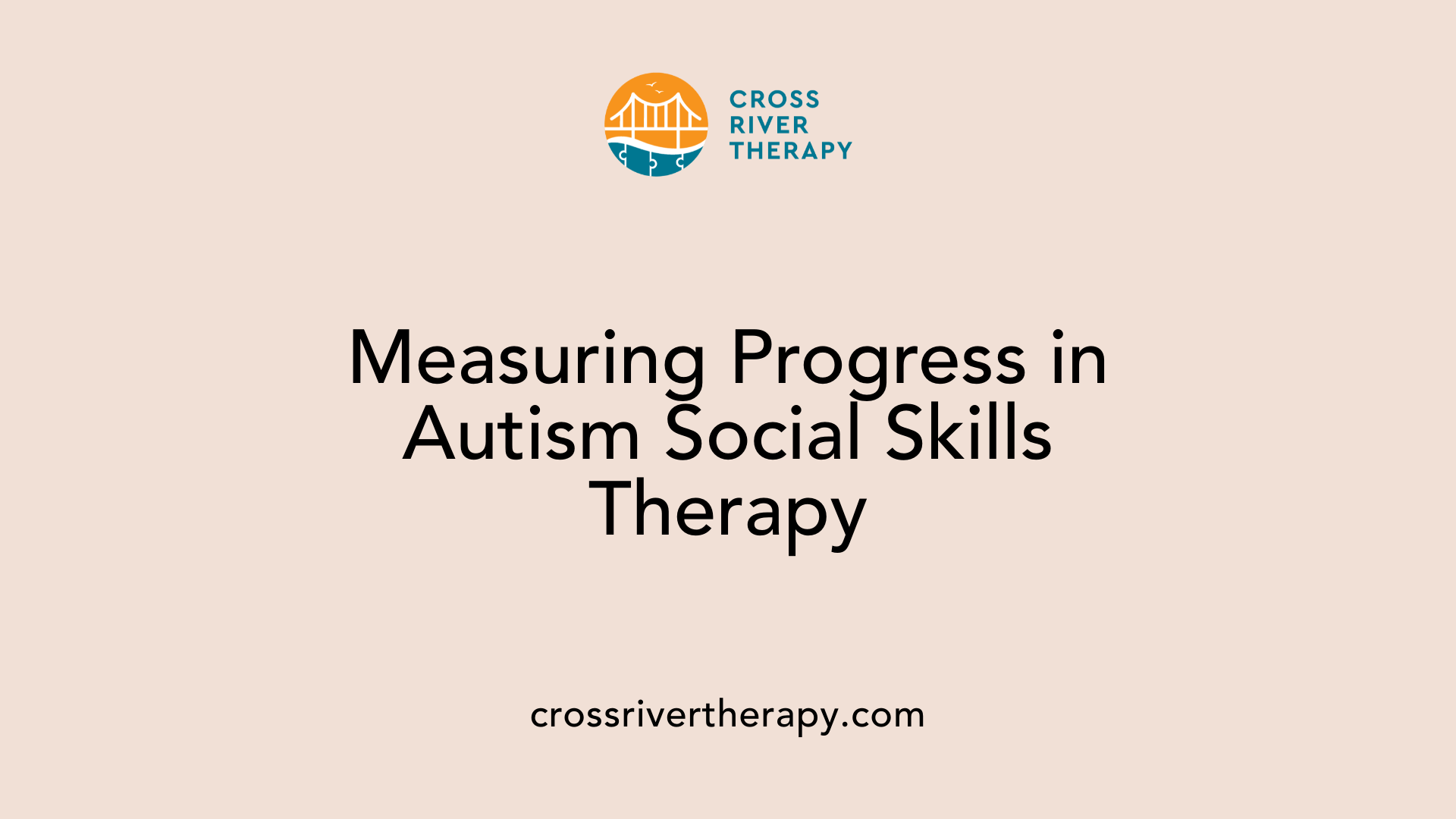How Cross River Therapy Helps Children with Autism Thrive in Social Settings
Empowering Social Growth for Autistic Children through Targeted Therapy
Introduction
Social interaction is a critical component of a child's development, and for children with autism, engaging successfully in social settings often presents unique challenges. Cross River Therapy, rooted in evidence-based practices, stands out for its excellence in helping these children build the necessary skills to connect meaningfully with the world around them. This article explores the specific methodologies employed by Cross River Therapy and how they support children with autism in thriving socially.
Understanding Autism and Social Challenges

Why do autistic children struggle with social interactions?
Children with autism often face significant challenges in social interactions due to factors such as lower Emotional Intelligence (EI) compared to their neurotypical peers. Understanding emotions—both their own and others’—presents difficulties, which impairs their ability to engage effectively in social settings.
Deficits in areas like perceiving, understanding, and managing emotions hinder their development of social competencies. Research has shown that many children with Autism Spectrum Disorder (ASD) struggle with recognizing emotions, a vital skill for navigating social situations.
What is the impact of autism on social skills?
Autism can significantly affect various social skills, including the ability to communicate reciprocally, interpret non-verbal cues, and engage in turn-taking during play. Factors such as impaired play skills can lead to difficulties in group work and decision-making.
ABA therapy systematically breaks down these interactions into manageable parts, utilizing techniques like shaping and modeling. By focusing on areas such as active listening, self-advocacy, and understanding social cues, children develop essential skills needed for effective communication.
Why is social skills therapy important for children with autism?
Social skills therapy is crucial for children with autism as it equips them with abilities necessary for meaningful social engagements, enabling friendships and enhancing their quality of life. By utilizing structured methods, therapy improves understanding of verbal communication and peer connections, fostering independence in various settings.
Additionally, it aids in addressing co-occurring conditions like anxiety and ADHD, further building confidence in social contexts. Targeted interventions not only support social skill development but also mitigate social isolation and misunderstandings, leading to improved integration into society.
The Foundations of Cross River Therapy
Core principles of Cross River Therapy
Cross River Therapy integrates a blend of structured and individualized approaches to foster social skills in children with autism. Central to this therapy is the utilization of Applied Behavior Analysis (ABA), which breaks down social interactions into smaller, teachable steps. This method allows therapists to focus on specific skills such as reciprocal conversations and active listening, making the learning process more manageable and engaging for children.
Role of ABA in supporting social development
ABA therapy plays a crucial role in empowering children with Autism Spectrum Disorder (ASD) to develop essential social skills. By employing techniques like positive reinforcement, therapists encourage children to engage in desired social behaviors. For instance, recognizing and responding to emotions is emphasized, aiding children in understanding both their own feelings and those of others. Furthermore, nonverbal communication training enhances children's ability to interpret facial expressions and body language, facilitating improved interactions.
Unique approaches implemented in Cross River Therapy
Cross River Therapy also adopts innovative strategies such as play therapy to strengthen social skills. By fostering trustful relationships between therapists and children, play therapy enables children to navigate social situations through guided play. This not only bolsters negotiation skills and emotional regulation but also promotes sharing and group collaboration. Additionally, individualized evaluations ensure that each child receives tailored support, focusing on unique challenges and interests to enhance their social self-efficacy.
| Approach | Description | Benefits |
|---|---|---|
| ABA Therapy | Structured, behavior-focused intervention. | Teaches specific social skills like active listening. |
| Play Therapy | Uses play to facilitate social interactions. | Develops emotional regulation and turn-taking. |
| Nonverbal Training | Focuses on interpreting body language and cues. | Enhances understanding of social interactions. |
What treatments are effective for enhancing the social skills of individuals with autism spectrum disorders?
Effective treatments for enhancing the social skills of individuals with autism spectrum disorders (ASD) primarily include behavioral approaches such as Applied Behavior Analysis (ABA), which focuses on reinforcing desired behaviors and reducing undesired ones. Techniques within ABA, like Pivotal Response Training (PRT), enhance motivation and communication initiation. Developmental approaches, including speech and language therapy, target communication skills, while occupational therapy fosters daily living skills. The Early Start Denver Model (ESDM) utilizes play to promote social and developmental skills in young children. Additionally, educational approaches like the TEACCH program employ structured environments to support learning and social engagement.
The Role of Structure and Individualization in Therapy

Importance of tailored approaches
Individualized approaches are crucial in ABA therapy, particularly for teaching social skills to children with autism. Each child has a unique combination of strengths, challenges, and interests, necessitating a customized plan to enhance engagement and maximize effectiveness. By tailoring interventions, therapists can ensure that learning is relevant and relatable, making it easier for children to grasp social concepts.
Structured social learning methods
ABA therapy employs structured social learning methods, such as discrete trial training and social stories. These techniques breakdown complex behaviors into manageable steps. By systematically teaching social skills, children can gradually build up their abilities in a structured manner. This approach not only helps in skill acquisition but also reinforces the generalization of learned behaviors across different settings.
Individual assessments in therapy programs
Proper evaluation plays a pivotal role in determining the most effective types of interventions for each child. Assessments gather insights into the child’s emotional intelligence, social cues interpretation, and self-advocacy skills. Based on these evaluations, therapy programs at organizations like Quality Behavior Solutions are tailored to create supportive environments that encourage meaningful social interactions, addressing each child's specific needs.
Positive Reinforcement and Behavioral Training

Use of positive reinforcement in ABA
Positive reinforcement is a fundamental element of Applied Behavior Analysis (ABA) therapy. By awarding children for exhibiting desirable social behaviors, this method encourages the repetition of these actions. This approach is particularly effective in teaching skills such as reciprocal conversations and active listening. By creating a system that rewards achievements, children feel motivated to engage socially, fostering an environment conducive to learning.
Impact on social interactions
The impact of positive reinforcement on social interactions is profound. When children receive feedback for their social advances, they become more aware of the behaviors that contribute to successful interactions. This method not only enhances their communication skills but also allows them to form meaningful connections with peers. As a result, children become increasingly adept at navigating social situations, leading to improved confidence and reduced anxiety.
Encouraging positive social behaviors
Through structured training, ABA therapy helps children with autism learn necessary social cues and interactions. Techniques like modeling and shaping, paired with positive reinforcement, ensure that children are recognized not just for the attempts they make, but for the successful execution of complex social behaviors. This continuous support encourages children to build and sustain positive social behaviors, enabling them to thrive in various environments and social contexts.
Play Therapy: Engaging Through Play
Benefits of Play Therapy for Autistic Children
Play therapy provides a unique avenue for autistic children to develop essential social skills in a naturalistic setting. It not only improves their negotiation abilities and problem-solving skills but also assists in developing manual dexterity, sharing, decision-making, and group work skills. By participating in recreational activities of their choosing, children can express themselves creatively, which helps transition unwanted behaviors to more appropriate, non-injurious behaviors.
Different Types of Play Therapy
There are various forms of play therapy suitable for children with autism. Two prominent approaches include:
- Child-Centered Play Therapy: Focuses on giving children the space to explore their emotions and experiences through play.
- Sensory Integration Therapy: Aims to improve sensory processing abilities, enhancing children's ability to engage socially.
Tailoring play therapy to each child's unique needs through proper evaluation ensures that it effectively addresses their specific challenges and strengths.
Enhancing Social Skills Through Play
One of the core objectives of play therapy is to foster emotional regulation while developing trusting relationships with therapists. This safe environment allows children to learn various social interaction styles over time. Furthermore, by recognizing and responding to social cues—be it body language, facial expressions, or tone of voice—children greatly enhance their social understanding. As they engage in play, they also refine active listening and self-advocacy skills, empowering them to communicate their needs effectively, which is vital for their autonomy and emotional growth.
Developing Emotional Intelligence in Children with Autism
Challenges with emotional intelligence in ASD
Children with Autism Spectrum Disorder (ASD) often struggle with emotional intelligence (EI), which involves perceiving, understanding, and managing emotions. These challenges can affect their social interactions, making it difficult to engage with peers and comprehend social cues.
Strategies Used in Therapy to Enhance EI
To address these difficulties, tailored interventions can be employed. Programs focusing on social and emotional learning (SEL) have been effective in bolstering emotional and social skills in children with autism. Through techniques like biosocial feedback and biofeedback, children learn to recognize emotional responses, enhancing their ability to interpret and navigate complex social environments.
Role of Emotional Recognition and Regulation
Incorporating training on identifying emotions within therapies, such as ABA, is crucial. Children learn not only to understand their own emotions but also to recognize emotions in others. This understanding fosters empathy, improves communication, and helps manage destructive behaviors, ultimately facilitating a smoother integration into social situations.
| Topic | Description | Benefits |
|---|---|---|
| Emotional Intelligence (EI) | The capacity to recognize, understand, and manage emotions. | Promotes better social interactions. |
| Challenges in ASD | Deficits in emotion perception and understanding common among children with autism. | Increases awareness of social cues. |
| Therapy Strategies | Implementing SEL and emotional recognition training to improve EI levels. | Enhances social competence and empathy. |
| Emotional Regulation | Teaching children to manage their emotions effectively through various therapeutic interventions. | Reduces anxiety and promotes healthy interactions. |
Enhancing Emotional Regulation and Expression
Biosocial Feedback Approaches
Biosocial feedback is an emerging technique that enhances the understanding of emotions in children with autism. This method teaches children to recognize their emotional responses, which is essential for emotional regulation. By providing immediate feedback on their emotional reactions, children learn to connect their feelings with their behaviors in a more conscious manner.
Improving Emotional Responses
Incorporating emotion recognition training into therapy is crucial for improving emotional responses. Children with Autism Spectrum Disorder (ASD) often struggle to identify their own emotions and those of others. Targeted interventions can enhance their ability to perceive emotions, which in turn boosts their social competence. Programs focusing on social and emotional learning (SEL) can have profound effects on these children's emotional skills.
Integrating Emotions into Social Skills
Integrating emotional understanding into social skills training is vital. Recognizing social cues such as facial expressions, body language, and tone of voice helps children navigate social situations successfully. This facet of training not only improves communication but also fosters empathy, allowing children to form meaningful connections with peers. As children become more adept in these areas, their overall social interactions and emotional regulation improve, promoting a better quality of life.
Utilizing Social Stories and Visual Aids
How do visual aids improve understanding?
Visual aids are powerful tools in ABA therapy for children with autism. They simplify complex social concepts, making them more accessible. By using pictures, diagrams, or videos, children can visually grasp social interactions, which may be challenging for them to understand through verbal instructions alone.
Visual aids can also assist in understanding social cues such as facial expressions and body language, boosting nonverbal communication skills critical for social engagement.
How are social stories implemented?
Social stories are personalized narratives designed to teach children about various social situations and expected behaviors. They break down interactions into clear, manageable steps, providing context and explanation for what might happen in different scenarios. This method prepares children for forthcoming social interactions and reduces anxiety by setting expectations.
How do these tools help children anticipate social situations?
By utilizing social stories and visual aids, children can better anticipate social situations. The stories often include what to expect, how to react, and the feelings of others involved, which enhances empathy. This preparation enables children to engage with their peers more confidently and effectively, ultimately improving their social skills and easing their integration into group activities.
Teaching Nonverbal Communication Skills
Importance of Nonverbal Cues
Nonverbal communication plays a crucial role in social interactions. Children with autism often struggle to interpret nonverbal signals, which can impede their ability to connect with others. Understanding cues such as facial expressions, body language, and gestures is essential for effective communication, allowing children to navigate social situations with greater ease.
Training in Interpreting Facial Expressions and Body Language
ABA therapy incorporates specific training to help children recognize and understand nonverbal signals. This involves systematic approaches such as modeling, where therapists demonstrate appropriate responses to various nonverbal cues. By engaging in interactive activities, children can practice interpreting these cues within a safe environment, facilitating better emotional understanding and interactions with peers.
Impact on Effective Communication
Improving nonverbal communication skills has a lasting impact on a child's overall social functioning. As children learn to read and respond to nonverbal cues, they become more adept at engaging in reciprocal conversations. This not only enhances their communication skills but also reduces misunderstandings and anxiety, ultimately fostering a sense of belonging in social settings. Programs such as those offered by Quality Behavior Solutions aim to empower children by equipping them with the tools necessary for successful social interactions.
Active Listening as a Core Social Skill
Why active listening is vital for social interaction
Active listening is a fundamental social skill that enables children to engage in meaningful conversations and develop relationships. For children with autism, effective listening goes beyond hearing words; it involves understanding context, emotions, and intent behind the spoken word. This skill facilitates reciprocal communication, making it a cornerstone of healthy social interactions.
How it's taught in ABA
In ABA therapy, active listening is often taught through structured exercises that emphasize key components of listening. Therapists model active listening cues, such as nodding and maintaining eye contact. Techniques like role-playing and social stories are used to illustrate effective listening in real-world scenarios, enabling children to practice and reinforce these skills tailored to their individual needs.
Benefits of improving listening skills in children with autism
Enhancing active listening skills has numerous benefits for children with autism. Improved listening fosters better communication, leading to fewer misunderstandings and conflicts in social situations. It also encourages children to express their thoughts and feelings, promoting emotional regulation and empathy towards others. As listening skills improve, children become more confident in social settings, ultimately enhancing their overall quality of life.
| Area of Focus | Benefits for Children with Autism | Teaching Techniques |
|---|---|---|
| Communication | Reduces misunderstandings; enhances social engagement | Role-playing; modeling |
| Emotional Regulation | Fosters understanding of feelings in self and others | Social stories; interactive play |
| Confidence in Social Settings | Improves self-advocacy and builds relationships | Feedback and reinforcement |
Integrating Self-Advocacy in Therapy
Teaching Children to Express Preferences
One of the core tenets of therapy for children with autism is teaching them to vocalize their preferences. Self-advocacy skills empower them to identify what they want and how they feel about different situations or activities. This practice not only fosters independence but also enhances their ability to engage in social interactions.
Importance of Self-Advocacy for Independence
Developing self-advocacy skills is crucial as it lays the foundation for greater independence. When children can effectively communicate their needs and wants, they are better equipped to navigate social settings and advocate for themselves in various situations. This independence translates to increased confidence and enhanced quality of life.
Incorporating These Skills in Therapy Sessions
Therapists can incorporate self-advocacy skills into their sessions through role-playing, modeling appropriate language, and using visual aids. For instance, engaging children in conversations about their likes and dislikes or preferences in activities not only promotes self-expression but also teaches important social cues. By making self-advocacy an integral part of therapy, children can learn to communicate more effectively, thus improving their interactions with peers and adults.
Support Through Parent and Family Involvement
Role of Parents in Reinforcing Social Skills
Parents play a crucial role in the reinforcement of social skills learned through therapy. By actively participating in their child's learning process, parents can help reinforce desired behaviors at home. Encouraging practice of new skills in everyday scenarios, such as asking for help or engaging in conversations, bolsters children’s confidence and competence in social interactions.
Family Dynamics in Therapy
Family dynamics significantly influence the therapy process. When families work collaboratively with therapists, they establish a supportive environment for the child. Family engagement fosters trust, communication, and consistency. These elements are essential for effective therapy and can help a child feel secure as they navigate social interactions both in and outside the therapeutic setting.
Tools for Supporting Children at Home
To help children generalize their social skills, families can utilize various tools at home. Resources such as social stories can summarize appropriate social behaviors and scenarios. Additionally, engaging in play that mirrors therapy exercises can aid in reinforcing skills like turn-taking or following rules. Parents can also use everyday moments to teach emotional recognition and response, which are vital for improving social interactions.
Ultimately, a strong partnership between families and therapists is essential in promoting the social skills development of children with autism.
Generalizing Skills Across Settings
Goals of Generalization in ABA
One of the primary goals of ABA therapy is to ensure that the social skills learned by children with autism can be generalized across different environments. It's not enough for these skills to be displayed in a clinical setting; children must be able to apply them in real-life situations, such as at home, school, or in community interactions. This enables them to thrive in varied settings and build meaningful connections with peers and adults alike.
Challenges in Applying Skills in Various Environments
Children with autism often face obstacles in transferring skills from one context to another. Factors such as differences in social norms, unfamiliarity with the environment, and varying levels of support can hinder their ability to use their learned skills effectively. Additionally, variations in the presence of social cues can also complicate their understanding of social interactions.
Strategies for Successful Skill Transfer
To facilitate successful generalization of skills, several strategies can be implemented:
- Role-Playing: Practicing various scenarios can help children prepare for real-life encounters.
- Consistent Reinforcement: Using positive reinforcement across different settings encourages children to use their skills.
- Parent and Teacher Collaboration: Training parents and educators to be consistent in applying learned skills can support the child's efforts in diverse situations.
Effective interventions like these not only aid in the retention of learned social skills but also enhance the overall quality of life for children with autism.
Peer Interaction and Learning Opportunities

Use of Peer Modeling
Peer modeling is an effective strategy in ABA therapy that promotes social skill development among children with autism. By observing and imitating their peers, children can learn vital social behaviors in a natural and engaging context. This model not only facilitates social interaction but also helps them build friendships and navigate various social situations, ultimately leading to enhanced social competence.
Benefits of Social Skills Groups
Participating in social skills groups can offer children a structured environment to practice these learned behaviors alongside their peers. Some benefits include:
- Facilitated Practice: Provides opportunities for children to engage in role-play scenarios that mimic real-life interactions.
- Peer Feedback: Children receive constructive feedback from peers, encouraging them to refine their social skills.
- Diverse Interaction: Exposure to various personalities in a group setting helps children adapt to different social styles.
Encouraging Inclusive Social Practices
Creating inclusive social practices is crucial for integrating children with autism into everyday settings. Strategies may encompass:
- Friendship Building Activities: Organizing joint activities that involve both neurotypical children and those with autism helps foster connections and understanding.
- Peer Support Programs: Training peers to understand the challenges faced by their classmates can promote empathy and support.
- Community Events: Engaging in inclusive community events ensures children with autism have access to social experiences that enhance their skills in a broader context.
These peer interaction strategies can transform the social landscape for children with autism, leading to lasting relationships and improved quality of life.
Evaluating the Success of Therapy

Metrics for Assessing Progress
Evaluating the effectiveness of ABA therapy in developing social skills for children with autism involves a range of metrics. These can include direct behavioral observations, progress tracking sheets, and standardized social skills assessments. By measuring specific behaviors before and after therapy, therapists can gain insight into the child's development.
Indicators of Social Skills Improvement
Improvement in social skills can be identified through various indicators. For instance, an increase in successful reciprocal conversations demonstrates enhanced communication abilities. Other signs include improved ability to interpret nonverbal cues, successful turn-taking during play, and a greater ease in engaging with peers. Tracking these behaviors overtime helps establish patterns of growth in social interactions.
Adaptations Based on Ongoing Assessments
Ongoing assessments are critical in tailoring interventions to meet the individual needs of each child. If a child struggles with specific social cues, therapy can adapt to emphasize those areas more intensely. Conversely, when certain skills show significant improvement, the focus can shift to more complex social interactions. This individualized approach ensures that therapy remains relevant and effective as the child continues to grow.
Future Directions in Autism Social Skills Therapy
Emerging Methods and Tools
In the realm of autism therapy, new strategies are evolving to enhance social skills training. Tools such as virtual reality (VR) are being explored to create immersive social scenarios, allowing children to practice interactions in a controlled setting. These innovative tools can simulate real-world environments and provide instant feedback, aiding in better emotional and social skill development.
Trends in Therapeutic Practices
A significant trend is the increasing emphasis on individualized therapy plans. Tailoring interventions based on each child’s unique strengths and interests not only engages them better but also leads to more effective learning outcomes. Therapeutic practices like child-centered play therapy and sensory integration therapy are gaining popularity, highlighting the importance of emotional connections in fostering social skills.
Innovations in Therapy Technology
Integrating technology into therapy practices is becoming commonplace. Apps designed to enhance emotional recognition and communication skills are being utilized in conjunction with traditional methods. These digital tools support skill retention and facilitate parent involvement, creating a collaborative environment for the child’s social development.
| Topic | Description | Example |
|---|---|---|
| Emerging Methods | Innovative, immersive environments | Virtual reality scenarios |
| Trends in Practices | Individualized therapeutic approaches | Tailored play interventions |
| Innovative Technology | Digital tools aiding emotional recognition | Apps for social skills training |
Conclusion
Cross River Therapy offers a comprehensive and individualized approach to developing social skills in children with autism, employing a blend of evidence-based practices. By addressing the emotional, communicative, and social nuances of autism, the therapy not only helps children navigate their world more effectively but also enriches their quality of life. As new methods and technologies evolve, the potential for deeper and more impactful therapy outcomes grows, promising a brighter social future for children on the autism spectrum.
References
- How ABA Therapy Can Help Children with Autism Thrive
- Play therapy in children with autism: Its role, implications, and ...
- Considerations About How Emotional Intelligence can be Enhanced ...
- How ABA Therapy Helps With Social Skills
- Understanding Social Cues: A Quick Start Guide for Autism
- Autism and Social Skills Development
- Tool Kit Excerpt - Autism Speaks
- Social skills and autism | Autism Speaks



